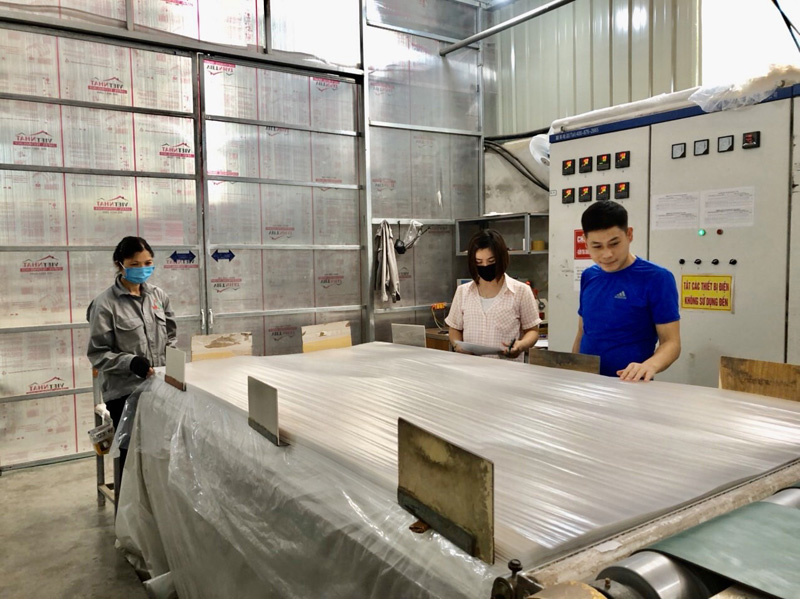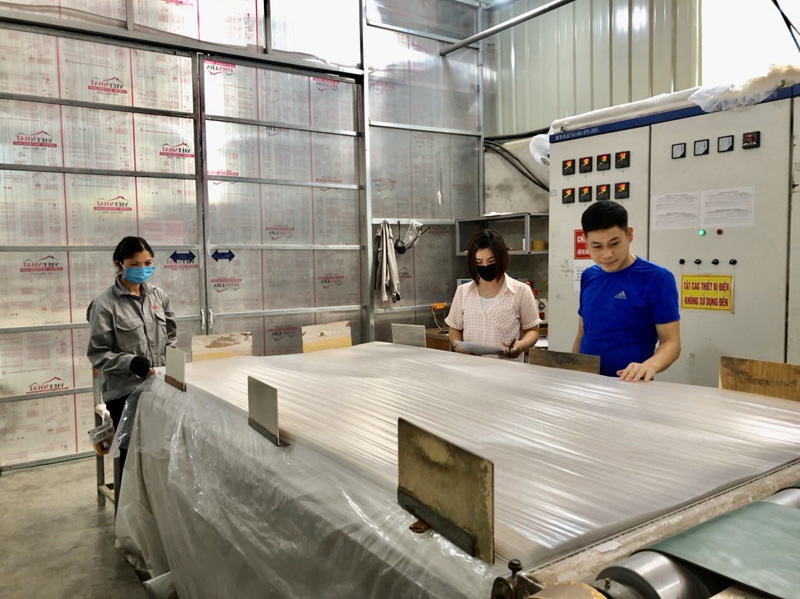
(HBO) - On July 13, 2017, the 16th provincial Party Committee issued Resolution 17 on developing the province’s driving force zone until 2020, with a vision to 2030. This resolution grouped nine communes and townships of Lac Thuy commune into the economic driving force zone. After the merger of administrative units, the zone currently comprises six localities, namely Ba Hang Doi township, Chi Ne township, and the communes of Phu Thanh, Phu Nghia, Dong Tam, and Yen Bong.
 Workers of the WILLSON joint Stock Company, based in Phu Thanh commune
of Lac Thuy district, produce wooden items and floorboards.
Workers of the WILLSON joint Stock Company, based in Phu Thanh commune
of Lac Thuy district, produce wooden items and floorboards.
With high political resolve, Party committees
and authorities in Lac Thuy have carried out concerted and breakthrough
solutions to help the district tap into its potential.
The district considers investment attraction as
a breakthrough solution to develop the economic driving force zone. Thanks to
considerable efforts by local authorities over the past years, Lac Thuy has
made steady strides in investment attraction, thus creating an optimal and fair
business climate for businesses and investors. It has also increased
coordination in trade promotion, participation in fairs and exhibitions,
popularisation of its image, and infrastructure building, especially in
industrial clusters.
The lodestar for this focal task was the
district Party Committee’s Resolution 14, issued on April 16, 2013, on
investment attraction for 2013-2018. As a result, Lac Thuy was home to 45
projects with total registered capital of nearly 14 trillion VND as of June
2018. The number of projects increased to 50 and capital to over 17 trillion
VND by the end of 2019, including 28 industrial projects, nine agricultural
projects, and seven mineral mining and processing ones.
To promote the effectiveness of investment
attraction, Lac Thuy has made use of every capital source from the central and
local budgets to develop infrastructure at industrial clusters.
In particular, Hoa Binh province’s key projects
in the district are being accelerated, including the Huong Binh cable car
project worth over 1.7 trillion VND of the Pacific Corporation in Phu Nghia
commune, and the Xuan Thien lime and calcium carbonatepowder factory
invested with more than 8 trillion VND in Yen Bong commune.
Authorities of Lac Thuy are set to select
projects that have least impact on the environment, especially in the upstream
Boi River which supplies water for locals’ daily use, and focus on
environmentally friendly projects like eco-tourism, resort, golf and cable car
ones./.
In Hoa Binh province, 11 traditional craft villages with more than 400 small-scaled production households have put in place a clean and green production model, establishing new standards for sustainable development. Waste collection sites and wastewater treatment facilities have been meticulously managed by local residents.
To make it easier for the residents to handle administrative procedures, Yen Bong Commune (Lac Thuy District) has identified the administrative reform as one of its key tasks. By implementing a range of synchronized solutions, the commune has seen the positive changes in the administrative reform, meeting the needs of its people.
Mai Chau district has firmly established itself as a standout destination on Vietnam’s tourism map, attracting both domestic and international visitors with its breathtaking landscapes, rich ethnic culture, and warm hospitality. However, beyond its natural and cultural charm, a secure and well-managed tourism environment has added to Mai Chau’s appeal.
As Vietnam enters a new phase of economic and administrative reform in 2025, Hoa Binh province is stepping up its efforts to streamline governance, boost economic growth, and attract investment.
The Hoa Binh provincial People's Committee held its monthly meeting on March 26 to review the progress of key projects, assess budget revenue and public investment disbursement, provide feedback on draft documents for submission to the provincial Party Committee's Standing Board, and discuss other important matters related to the committee's governance activities.
Playing a key role in Hoa Binh province’s economic development, Luong Son district has been focusing on science and technology development, innovation, and digital transformation.



 Workers of the WILLSON joint Stock Company, based in Phu Thanh commune
of Lac Thuy district, produce wooden items and floorboards.
Workers of the WILLSON joint Stock Company, based in Phu Thanh commune
of Lac Thuy district, produce wooden items and floorboards.